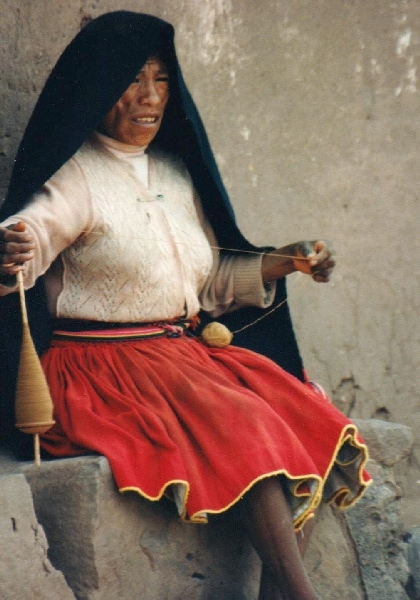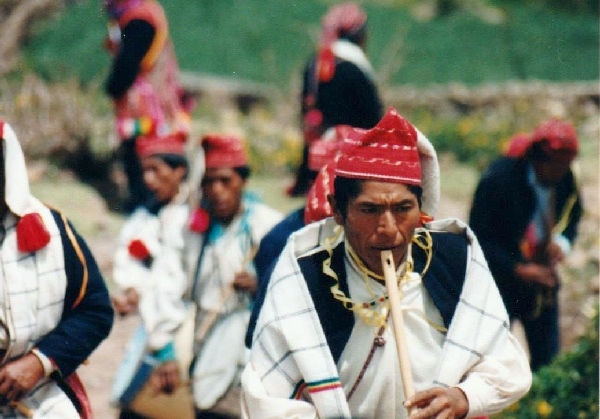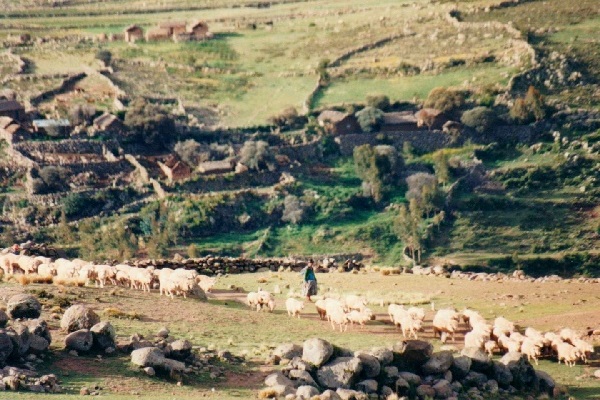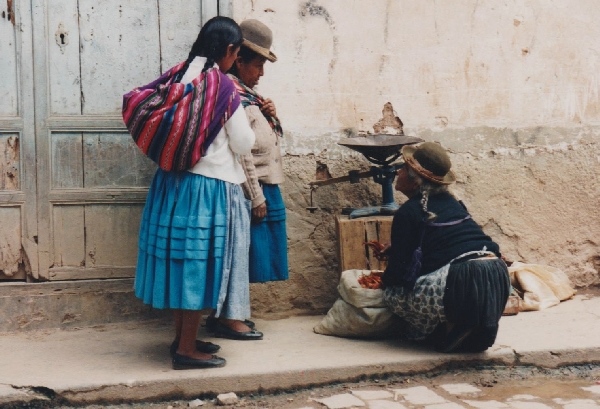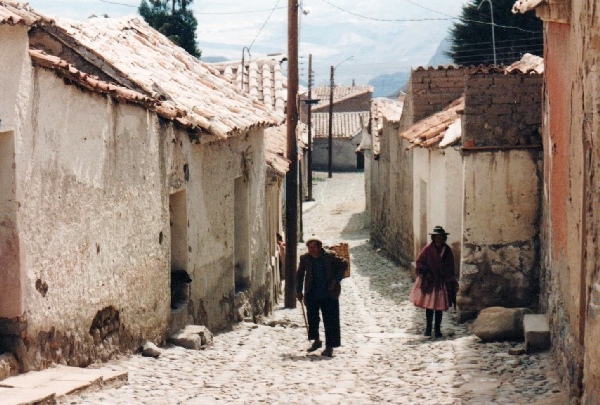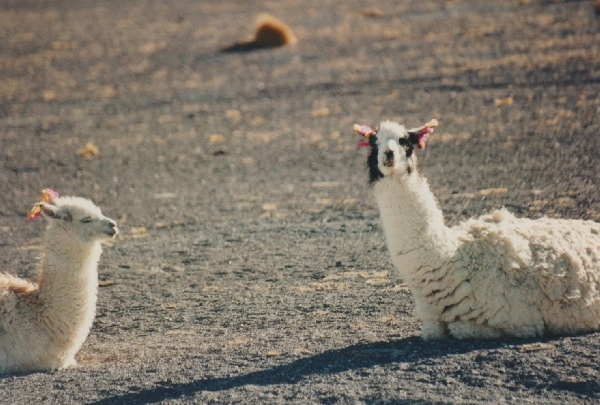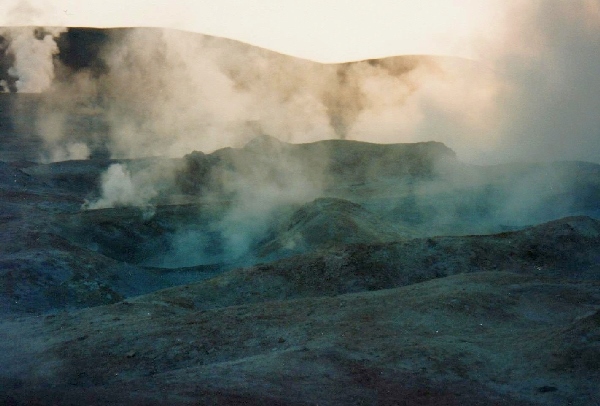World traveler Clown Tom Bolton
Adventure stories & photos

Tom’s travel to Bolivia, South America
Copacabana & Isla del Sol, Lake Titicaca
In 1996 I returned to Peru, visiting the southern part of the country and continued into Bolivia, which turned out to be my favorite country in South America. I crossed the border along the huge lake called Titicaca via the Peruvian town of Puno to Copacabana, the main Bolivian town on the lake. There was a carnival celebration going on in Copacabana and the locals were all dancing around.
Basilica of Our Lady of Copacabana
The celebrations were also going on in front of the church known as the Basilica of Our Lady of Copacabana. This seem,ed to be teh central meeting point of teh town. I wouldn’t really consider carnival as a religious holiday but the church seems to pre-empt any kind of indigenous celebration, since they can’t suppress them anyway, just assign some churchly significance and accept them. The Basilica itself is supposed to have been built on top of ruins of an Indian temple to the god of futility, which is said to live in the lake. Below right, another view of the Basilica from above.
Isla del Sol, Lake Titicaca, Bolivia
From Copacabana, I took a boat to the nearby Isla del Sol, which is one of the biggest islands in the lake and a sacred place for both the Incas and the original inhabitants, the Aymara Indians. After disembarking, I hiked across the island to a village where there was accommodation for the night. Many locals were wearing full traditional costumes which I had the impression were more brought out for the carnival celebrations than used strictly for daily usage. Not that they don’t still wear them but I think they were their best cloths. I was surprised that the costumes were distinctly different than in Copacabana – which were in turn similar to in Puno, Peru across the lake. Black, red and white seemed to be the dress code of the island. One woman was spinning thread or yarn in a traditional method and the kids also seemed to enjoy themselves. Many people were playing drums or flutes and many seemed fairly drunk.
Pathways, ruins across Isla del Sol, Bolivia
It took a a better part of a day to hike across the island so it was not so small. But I don’t remember seeing any real roads or cars out side the villages at the harbors – just wide pathways. There were many stone walls and ruins but nothing on an impressive scale.
The Capital La Paz
Arriving in La Paz, I spent a couple of days wandering the streets seeing the old buildings and generally just hanging out. There were not so many western tourists around and I was feeling pretty dirty having been on the road for some weeks without an opportunity to wash any cloths. The air quality was very bad and combined with the altitude really made my asthma flair up.
Souvenir shops of La Paz, Bolivia
Checking out the many souvenir shops was also a great past time in La Paz. Otherwise, there was not much nightlife but it was relatively quiet and safe for a large South American city. Wandering the narrow streets of the old center, one felt more like being in a village. By far the largest city in Bolivia, La Paz is not actually the capital. That honor belongs to Sucre, a trivia question that I often forget myself! It takes a moment for one to figure out what one is looking at in the photo below middle left and not just because it is a bit blurry! This was a typical shop selling traditional medicines and objects for religious (as in black-magic) purposes. Lots of dried plants and skinned carcasses of animals like birds and baby lamas or maybe they are alpaca or visuñas. Like, who can tell but it all looked very creepy.
Strikes and heavy police presence
There seemed to be little criminality in La Paz and I returned there a number of times without incident as I zigzagged around the country. But the last time I passed through, towards the end of my stay in Bolivia, there was civil unrest due to political conflicts, which lead to strikes and demonstrations and a heavy police presence. The quiet plaza shown above was transformed into a display of hard-handed police control shown in the following pictures.
People think of how South Africa went to majority rule while avoiding a race war but Bolivia is also notable. Most Latin American countries have had conflicts between the indigenous people and the usually European descended ones who seem to control most of the wealth and power. Now they have a president who is an Indian himself and suddenly some people are jittery about his left leaning tendencies. Well, the majority of the population of Bolivia is Indian and it’s about time their needs and wishes are listened to. Considering the situation, I was surprised there wasn’t more resentment of gringos there.
On to Potosi, Bolivia
After La Paz, I headed south to Potosi, which is well known for its silver mines. The city has many colonial buildings left from the Spanish but it has really run down and lost its importance once the mines were mostly depleted. Most tourists go on mine tours but my clothes were already so dirty and my asthma so bad that I shuddered at the very thought. Most of the churches were closed up but I visited the touted museum in the mint. Didn’t see many foreigners around although the first 3 hotels I tried claimed to be full, everyone on a mine tour or what? The town is overlooked by a mountain known as Cerro Rico which is riddled through with mines. I only stayed a night but would pass through Potosi again on my way to the Uyuni salt flats.
From Potosi to Sucre & Tarija
After 2 days, I took a bus north to Sucre. Was chaotic as there were 2 buses and they were trying to put people on one and their baggage on the other. I got on bus to find that another guy had the same seat number and they switched me to the other vehicle. Old man with one eye sat next to me. At a relief stop he went to pee but didn’t manage to get his pants down first. Had a wet streak all the way down his pants-leg and stunk the rest of the trip.
Although the capital of Bolivia, Sucre was very quiet. The only local entertainment seemed to be video arcades and the few recommended bars were empty. I visited a church my guidebook claimed is one of the gems of Latin America but I found it nothing other than big. I felt bored so I grabbed a bus back south to Potosi and changed for Tarija. The road was crumbling and traveling on it actually scared me more than the so-called “highway of death” I experienced a few weeks later. I found the climate in Tarija pleasant, sunny and warm and everything was green; the people seemed happy and prosperous but there was not much to see. After 2 days I caught a flight east to Santa Cruz.
Santa Cruz, Bolivia
Santa Cruz, even more so than Tarija, is much lower altitude than the highlands and was hot and humid, a real change from most of the places I had been. Despite the nearly tropical climate, I didn’t see many outdoor cafes and few restaurants at all. I looked into excursions around Santa Cruz but most seemed to be to places hundreds of kilometers away or one need to have their own vehicle.
I did met a girl who took me to a very dark disco to dance and when I returned to my hotel I just wanted to sleep but a group of young Israelis were yelling around to all hours. Seems that one of the girls had lost someone in a recent Hamas bombing but mostly they were just partying. I very respectfully asked them to quiet down but they just got nasty and kept making noise. Not the first or last time I would have this problem with Israeli travelers.
One or two Israelis were usually fine but in a group they always acted like they owned the world and showed no respect to either locals or fellow travelers. Even many Israelis, usually ones with a bit more maturity, have confided to me that they themselves have problems with this and go out of their way to avoid the Israeli hangouts. After a couple of days I caught a bus to Cochabomba.
Cochabomaba
We went through 3 police controls on the road to Cochabomba where everyone had to disembark and the bus was searched for coca leaves. There are supposed to be lots of coca plantations in that region but I somehow doubted that any of the big producers would be transporting their crop on such an intercity bus. Cochabomba was very lively; finally a place with lots of bars, restaurants, pizzerias and cafes.
Second day in Cochabomba, I went to the village of Quillacollo – nothing there. On to Sipe-Sipe where I walked for hours up a mountain along an almost dry streambed until I found an established trail and followed that for hours… Never did find the ruin of Inka-Rakay that I was looking for but it was a pretty hike anyway. There were plenty of popular bars but people seemed to be in unapproachable groups.
Wanted to see a video about Chile at the culture center but nobody else showed up for the 10 pm showing and they cancelled it. Not sure how much interest there is in Bolivia for foreign places even if next door. Went back to hotel but had trouble sleeping because every 30 minutes another guest would arrive and have to ring the loud bell to get let in and another group of Israelis were making a loud party.
Just hung out next day and finally saw film in the evening at Culture Center. Story about a lawyer and his wife who get a flat tire while driving in the pouring rain. They get a lift from a doctor who she recognizes as one of her torturer and rapists when she was imprisoned by the military. She wants to kill him but settles for getting him to simply confess what he did. Pretty heavy political commentary on what happened in Chile under Pinochet. In the morning, I caught a bus back to La Paz.
Sorata, Bolivia
After a night back in La Paz, I went northwest to the village of Sorata, which was surrounded by beautiful terraces. First day I just strolled around, the second day I went to see the Gruta de San Pedro. It is a large, extensive cave, full of bats, which I only got to see for 10 minutes as the lady didn’t want to turn the lights on longer for just one person although I had paid the full admission. From there I tried to walk to a lookout point but didn’t find the way. Next day, I walked a long way towards the road back to La Paz. Didn’t get lost but took the wrong trail which doubled the distance to get back.
Had interesting talk to owner of the hotel where I was staying who came from Quebec, Canada. The colonial style building had been a trade store and warehouse for quinine and later rubber. But as these markets disappeared the area lost its viability. Although it was beautiful there, he said that the locals were often jealous of an outsider’s success and made life difficult for him although he married a Bolivian. Slashed tires and a poisoned dog were on the list if I remember correctly.
Had another day just hanging out in hotel and reading due to rain and following day walked along a nearby river to San Pedro and followed some landslide scarred trails which became so narrow that I finally turned when I realized that I could easily slip and fall to a certain death. Next day, I went to La Paz where I spent the night and had to go to get a visa extension since I realized my 30 days were nearly up. Took half of the day, as office was not where I expected it to be, the other half was wasted unsuccessfully trying to get a bus ticket on to Coroico.
Trip to Coroico and the Yungas
Got up early and found no bus but a van headed northeast to the village of Coroico in a area known as the Yungas. Here the Andes dramatically drop off into lush, green subtropical lowlands. One had a feeling of being at the edge of the earth and I had the illusion to actually sense the heat of the Amazonian jungle festering to the east. Fact is that the Amazon is still a long way off and there are more mountains in between.
On the road to Coroico, pictured below, if you go off the side of a mountain you’ll fall a loooong way down like something out of an old roadrunner cartoon. Vehicles headed uphill always had the right away and drove on the cliff side of the road, vehicles headed downwards on the outside lane. This has some logic but strange to think that the side of the road one drives on is variable! In 2007, I read an article about this road, which labeled it “the highway of death” due to the amount of traffic fatalities that have occurred there.
More recently, I read that a safer route has replaced this road and the old one is closed to vehicles but well used by tourists on mountain bikes looking for a thrill. It was impossible to get photos from the window of the van during the trip as one was constantly moving and being bounced around. We did stop along the way due to a traffic jam. The road is hardly wide enough for traffic going both ways. So when 2 trucks need to pass it is nearly impossible. I believe the following image might be from around Sorata but it gives one a bit of an idea.
Along the side of the road were many such crosses marking the spot of fatalities like in the photo above on the Sorata road. Often whole vans or buses that took the plunge. This is common throughout Bolivia and the Andes but here one could still see many of the wrecks below. I assume the corpses get recovered but such places were too inaccessible to bother removing the flattened vehicles. One has to wonder why so many drivers are still went so fast and reckless despite the dangers.
Coroico a quaint village
Not only was the landscape spectacular but the village of Coroico was also very quaint, just run down enough to add character without looking dirty. Otherwise, there was nothing to distinquish it from most towns in Bolivia.
Basic room but spectacular scenery in Coroico
My accommodation was pretty basic was most of my time in Coroico was spent walking around enjoying the landscapes.
Stuck in La Paz and finally on to Uyuni
Despite its beauty, there wasn’t much to do around Coroico but walk around which was difficult because of the biting flies. And if you dressed heavily enough to protect yourself from the insects, then you sweated to death. So I only stayed 2 nights and then went back to La Paz where I hung out for a few days. There were public strikes throughout Bolivia closing the museums and stopping all public transportation.
A bunch of other tourists and I wanted to get to Uyuni and got tired of waiting around. Through a travel agency, we arranged for a private bus to pick us up outside of town and to bribe the local striker organizers to let us leave peacefully. Unfortunately, some locals didn’t go along with the plan. Before we could board, they started throwing stones and the bus driver, not wanting to get the windows broken, kept driving out of their reach. They ended up chasing the bus for kilometers, with us running across the desert with our heavy backpacks trying to catch up and board it.
It was surreal since we were generally twice their size and had them outnumbered as well. Half of the tourists were young Israelis fresh from the military. A good run through the desert with a heavy load and stones flying was probably just routine for them but it was ball breaking for me. It would have been easier just to punch one of them out as an example and send them on their way but nobody wanted to use violence since we basically had nothing against their goal of striking for fairer conditions.
From Uyuni, I booked a 4-day tour with 7 other backpackers, which visited the Salar de Uyuni (Uyuni salt-flats) including places where the salt is dug up for commercial purposes.
Tables, chairs even a hotel from salt
There was even a hotel out on the flats constructed totally of blocks of salt. Outside they sold souvenirs like table and chairs in the shape of lamas carved from salt. Problem was that the tourists all came on tours and most were backpackers; like how was someone going to buy a single chair, non-the-less a set with table and be able to transport it home from Bolivia? My tour was low budget and we spent the nights all crowded together into one-room hovels.
Mining operation, salt factory?
I found this photo of a mining operation with the others from my trip to Uyuni but don’t remember the details. It was not actually on the edge of the salt flat but towards Potosi which we went through on the way from La Paz. In addition to salt, lots of different minerals and rare metals are obtained almost exclusively in the high desert regions of southern Bolivia and northern Chile. Many of the newest high-tech equipment and electronics are dependent on them. I wonder if they will be the source of future wealth to the region as oil has been to the Middle-East or maybe the harbinger of similar conflicts as well.
Flamingos & other wildlife on saltflat
This high altitude lake is one of a few small remnants of a large sea and much saltier than the ocean yet it supports microscopic life which hundreds of thousands of flamingos there thrive on. Was amazing to see so much life in such an inhospitable environment.
Alpacas by salt lake
Along the banks were also some alpacas. I wondered if there could have been a more barren place to graze them and still find a few tufts of dry grass? One still sees many visuñas, which are the wild forbearers of lamas, in this part of the Andes. Much closer related to viscuñas are the alpaca which are domesticated but smaller than lamas and bred for their wool rather than used as pack animals.
Cacti dot perimeter
Rocky outcrops with big cacti characterized both the edges of the Uyuni salt flat and some virtual islands within it.
Volcanic vents & geysers
Some huge snowcapped peaks many of which were formed volcanically dot the altiplano. We visited one area that has a lot of thermal activity including steam vents and geysers. We were there shortly after sunrise and it was an almost magical sight as we wandered around these steam vents with the sunlight coming across the horizon. We swam in a thermal spring, which was a challenge because it was a cold morning and there were crusts of ice around. But I can’t help but think that once climate chnage wipes out those snow and glaciar reserves, there will be nothing left but desert. I’m sure tourists will still go to visit but not sure how the locals in such regions of Bolivia will survive.
On to Chile
Our tour was private transportation and there was nobody around on the salt flat, so we had no further problems with strikes. But as further travel in the Bolivia was questionable, most of us arranged to be taken across the border to San Pedro de Atacama, Chile. I had been there just the year before and I eventually had to return north to Lima for my return flight but it was easier to take this swing south and from there down to the coast and go north from there.
So, those were just a few tales from my many travels over the last thirty and something years. I hope you've enjoyed another side of a traveling clown! If you want, write me an email or better yet, book my show or set a link to this website or just state me as the beneficiary of your will!
To book or see more information about Tom's clown show and entertainment, visit one or both of his clown websites:
Clown Stuttgart www.clowntombolton.com
Clown juggler Stuttgart, Gremany www.clown-event.de




















